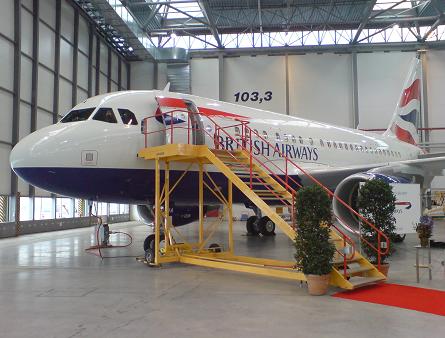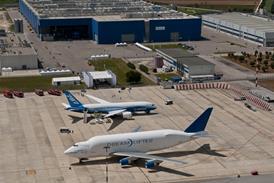British Airways is conducting steep-approach training at the UK Royal Air Force base at Lyneham ahead of placing its first all-business Airbus A318 into transatlantic service.
Having taken delivery of the twinjet (G-EUNA) on 28 August, BA has arranged for the military base to simulate the approach at London City, from where the carrier will launch flights to New York JFK on 29 September.
Runway marks imitate London City's touchdown zone and end point, while visual approach slope indicators will simulate the 5.5° glideslope. RAF Lyneham testing is scheduled to start on 3 September.
The airline has selected a complement of 28 captains and 26 co-pilots, drawn from its short-haul corps, to crew the transatlantic flights. "It's an aspiration bid and it's incredibly popular," says BA Airbus flight training manager Capt Simon Kinsey. "It's been massively oversubscribed."
Captains will perform three approaches at Lyneham and perform a London City visit. Co-pilot training will comprise approaches without landings, or simulator work. BA is hoping to supplement Lyneham training, ahead of first services, on A320 simulators, with software to replicate A318 flight characteristics and the London City approach.
 |
|---|
© David Kaminski-Morrow |
In the overhead panel of the A318's cockpit, Airbus has fitted a simple 'steep approach switch' in the slot reserved for the 'N1 mode' thrust-control switch on International Aero Engines V2500-powered A320s. The slot is free because the V2500 is not an option on A318s.
Arming the switch will place the A318 into steep-approach mode as the speedbrake is deployed, as long as the flaps are fully extended and the landing-gear down, raising the outboard spoilers, numbers 3 and 4, to 30°.
BA's Airbus crews have been familiarised with oceanic procedures on Boeing 777 flights, but the first wave of A318 services will also carry a pilot who trains on the extended twin-engined operations fleet.
"It's not mandated, but it's something we feel will better support the crews," says Kinsey. The A318s are already approved for 180min extended twin-engined operations.
There will be no need for relief pilots, but each round trip requires three full crews. Crews will start at London Heathrow and transfer to London City for the westbound service to Shannon, where the jet will make a technical stop and change crew. A new crew will fly the aircraft to JFK, where a third crew returns it to City.
While a single crew could theoretically operate the entire westbound flight, the Heathrow-London City transfer counts as a sector, meaning crews would be pushing the edge of flight-duty times during the transatlantic leg, leaving no recovery margin in the event of a US East Coast diversion. A dedicated London City reporting station was considered, but rejected as an unnecessary complexity.
BA intends to carry three cabin crew on the 32-seat aircraft, although it has approval to reduce this to two if necessary.
The airline is intending to install a fuselage auxiliary tank modification, enabling the A318s to lift another 3t of fuel, although this will not feature on the aircraft at service launch.
"It will make no difference westbound but will give more flexibility on the return," says Kinsey.
Initial flights will be fully fuelled on the Shannon-JFK sector, to simplify processes in Ireland, but BA will refine this after three months based on gathered operational data.
London City airport is prone to weather disruption and BA has considered several options to balance customer and operational needs in case of diversion. It expects that most diversions would be to London Gatwick.
BA will use stands 23 and 24 at City, where it will also undertake manoeuvring tests with two aircraft. The airline expects to receive the second A318 in mid-October, enabling it to expand the JFK link to 11 flights a week.
"If we can get it a few days before launch then we could have it as a back-up for the inaugural," says BA corporate programme management team member Paul Beadsmoore. "But it's a nice-to-have."
Source: Flight International























